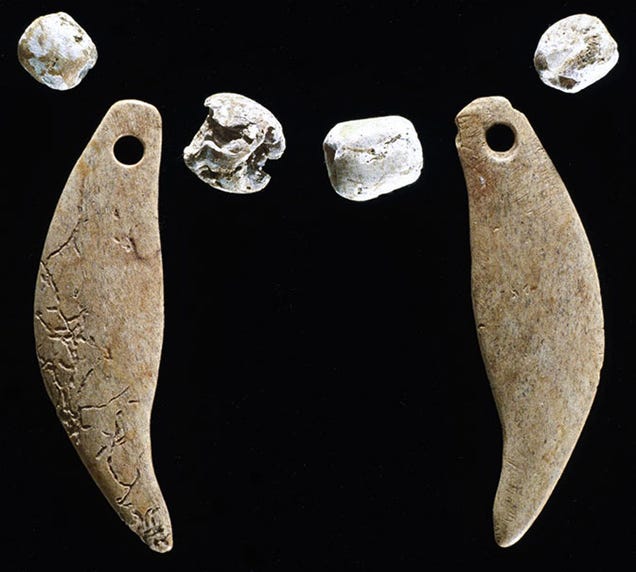https://www.google.com/url?rct=j&sa=t&url=http://io9.com/did-ancient-native-americans-try-to-domesticate-bobcats-1716200870&ct=ga&cd=CAEYACoTOTgwNzcxNTY3NzIzNjcxODE4MTIaZTc5ZTQ4NTgyNjA0Y2RkNTpjb206ZW46VVM&usg=AFQjCNG51xwMe5FtPSMIK00MBIWoveUNnA
Did Ancient Native Americans Try to Domesticate Bobcats?
and deliberately buried juvenile bobcat has scientists
wondering if it’s the first example of feline
domestication in the prehistoric Americas.
The remains of the bobcat were originally discovered in
the 1980s at the Illinois Hopewell Burial Mounds just
north of St. Louis. Archaeologists had mistakenly
identified the bones as belonging to a young dog and
placed it in the archives of the Illinois State Museum in
Springfield. Now, a new analysis by Ph.D. student Angel
a Perri and her team from the University of Durham in
the UK, has correctly identified the bones as belonging
to a bobcat (Lynx rufus) that was likely between four
and seven months old when it perished. The results
of their work can now be found at Midcontinental
Journal of Archaeology.
Journal of Archaeology.
Incredibly, the bobcat kitten was buried by a group of
Middle Woodland Native Americans in a very human-like
way, among the remains of humans and dogs. The bobcat
was adorned with a necklace made from seashells, along
with a bone carved to look like bear teeth (seen above).
What’s more, the complete skeleton showed no signs of
trauma, which suggests it wasn’t sacrificed.
The archaeologists say it’s “the only decorated wild cat burial
in the archaeological record” and that it “provides compelling
evidence for a complex relationship between felids and
humans in the prehistoric Americas, including possible taming
.”Alternately, the bobcat may have been buried not as a former
pet, but on account of its symbolic status— possible connection
to the spiritual world of the wild. As Grimm correctly points
out in his article, it’s virtually impossible to make a solid
determination of intent from just one specimen. Still, it’s
an incredibly unique and fascinating discovery.
in the archaeological record” and that it “provides compelling
evidence for a complex relationship between felids and
humans in the prehistoric Americas, including possible taming
.”Alternately, the bobcat may have been buried not as a former
pet, but on account of its symbolic status— possible connection
to the spiritual world of the wild. As Grimm correctly points
out in his article, it’s virtually impossible to make a solid
determination of intent from just one specimen. Still, it’s
an incredibly unique and fascinating discovery.
More at AAAS Science News. And read the entire study
at Midcontinental Journal of Archaeology: “A Bobcat
Burial and Other Reported Intentional Animal Burials
from Illinois Hopewell Mounds.”
at Midcontinental Journal of Archaeology: “A Bobcat
Burial and Other Reported Intentional Animal Burials
from Illinois Hopewell Mounds.”
The Elizabeth site is a bluff-top mortuary mound group constructed and primarily used during Hopewellian (Middle Woodland) times. Recent reanalysis of nonhuman skeletal remains from the site reveals that an intentional burial previously identified as a dog (Canis familiaris) is actually an immature bobcat (Lynx rufus). As a result of this discovery, we reevaluated eight other purported animal burials from Illinois Middle Woodland mounds, including seven dogs and a roseate spoonbill (Platalea ajaja). The dogs all appear to be intrusive or unrelated burial events, but both the bobcat and the roseate spoonbill were definite Hopewellian mortuary interments. The roseate spoonbill was decapitated and placed beside a double human burial. But the bobcat was a separate, human-like interment wearing a necklace of shell beads and effigy bear canine teeth. To our knowledge, this is the only decorated wild cat burial in the archaeological record. It provides compelling evidence for a complex relationship between felids and humans in the prehistoric Americas, including possible taming.
When Perri told [Kenneth] Farnsworth [a Hopewell expert at the Illinois State Archaeological Survey in Champaign], he was floored. “It shocked me to my toes,” he says. “I’ve never seen anything like it in almost 70 excavated mounds.” Because the mounds were intended for humans, he says, somebody bent the rules to get the cat buried there. “Somebody important must have convinced other members of the society that it must be done. I’d give anything to know why.”
Perri, who reports the discovery with Farnsworth and another colleague this week in the Midcontinental Journal of Archaeology, has her suspicions. The pomp and circumstance of the burial, she says, “suggests this animal had a very special place in the life of these people.” And the age of the kitten implies that the villagers brought it in from the wild—perhaps as an orphan—and may have tried to raise it. Bobcats, she notes, are only about twice the size of a housecat and are known to be quite tamable. The necklace seals the deal for her. She thinks it may have been a collar, a sign that the animal was a cherished pet. “This is the closest you can get to finding taming in the archaeological record,” says Perri, who believes the find provides a window into how other animals—whether they be dogs or livestock—were brought into human society and domesticated. “They saw the potential of this animal to go beyond wild.”












No comments:
Post a Comment